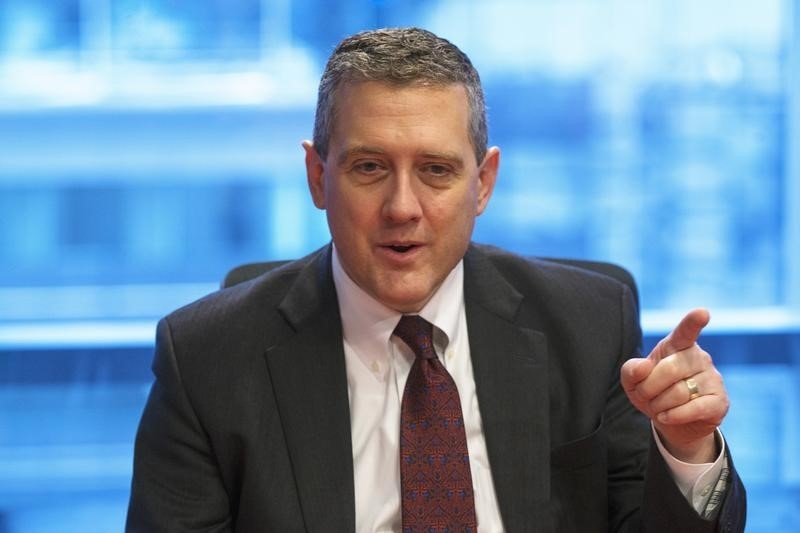Gold dips as ‘Fed superhawk’ Bullard caps metal’s biggest week in 30 months
2022.11.18 16:57
[ad_1]

© Reuters.
By Barani Krishnan
Investing.com — The naysayers to the gold rally may be right — once again.
“Fed superhawk” James Bullard’s comments that higher-for-longer interest rates will be the only way for the Federal Reserve to effectively bring inflation back to its 2% target knocked gold off its near $1,800-an-ounce perch, sending the metal with other risk assets like and lower for the week as the dollar rebounded from last week’s lows.
Bullion settled less than 1% down on the week and just about half a percent lower for Friday, keeping its $1,750-an-ounce support intact. But the market steam from last week that gave gold futures their best week in 30 months seemed to be evaporating, said traders.
U.S. gold futures’ benchmark contract finished Friday’s trading down $8.60 at $1,754.40 per ounce on New York’s Comex.
For the week, it fell $15. Last week, Comex gold rose $92.80, or 5.5% — its most for a week in 2-½ years since a 6.5% jump during the week to April 3, 2020.
The , which is more closely followed than futures by some traders, was at $1,749.01 an ounce by 16:00 ET in New York (21:00 GMT).
The which pits the greenback against the euro, yen, pound, Canadian dollar, Swedish krona and Swiss franc, was up 0.7% on the week. It tumbled 4% last week on expectations that the Fed might opt for smaller-sized rate hikes going forth — a notion Bullard virtually killed.
“I’m not really that bullish on gold anymore,” said Phillip Streible, chief market strategist at Blue Line Futures in Chicago. “Like most, I was expecting a clear break above $1,800. But that didn’t come, and it probably won’t after what Bullard said.”
U.S. inflation remains “unacceptably high” for the Federal Reserve to ditch jumbo-sized rate hikes in favor of only smaller increases, Bullard, who is president of the St. Louis Federal Reserve Bank, said Thursday.
“Thus far, the change in the monetary policy stance appears to have had only limited effects on observed inflation,” Bullard said in an analysis by the St. Louis Fed that debated the appropriate rate regime for the central bank after six since March.
Inflation, as measured by the , or CPI, expanded by 7.7% during the year to October, growing at its slowest pace in nine months. Prior to that, the CPI grew by 9.1% during the 12 months to June, its fastest in four decades.
The drop in the CPI came after the Fed added 375 basis points between March and November to rates, which were previously at just 25 points. Despite the central bank’s aggressive bid to get prices down, the CPI remains at more than three times the target of the Fed, which has vowed to bring inflation back to its 2% target.
Most economists, however, think the easing CPI will prompt the Fed to opt for a 50-basis rate hike in December, after four back-to-back increases of 75 basis points between June and November.
Bullard noted that the central bank’s policy-making Federal Open Market Committee, or FOMC, was seeking a future rate regime that would be “sufficiently restrictive”.
“While the policy rate has increased substantially this year, it has not yet reached a level that could be justified as sufficiently restrictive, according to this analysis, even with the generous assumptions,” Bullard said. “To attain a sufficiently restrictive level, the policy rate will need to be increased further.”
While Bullard did not specify what the future rate should be, he noted that there were currently ‘generous’ assumptions that favored a more dovish policy over a more hawkish one.
Bullard also said he would prefer rates to reach a peak of at least between 5% and 5.25% before a pause could be considered. Rates currently stand at a high of 4%.
On the question of disinflation, he said market pricing suggests this was likely to occur some time in 2023.
Analysts said Bullard, who has garnered the reputation of a Fed superhawk, had clearly knocked the wind off gold’s sails.
“It seems bullion traders are listening to the latest Fed speak more so than stock traders,” said Ed Moya, analyst at online trading platform OANDA. “The economic data is telling U.S. a mixed picture right now, but large parts of the labor market and factory activity resilience suggests inflation could be sticky next quarter, which could support the hawks at the Fed.”
Moya also said the path of least resistance for gold was lower and that could continue if the FOMC meeting minutes from November, due imminently, support the idea that December’s rate could still be hawkish. Comex gold got to as high as $1,791.80 on Tuesday, its highest since Aug. 12. It has given back about $37, or 2%, from that peak.
“The Fed will want to keep all tightening options available and they will likely say that a half-point rate increase doesn’t mean they are at the end of their tightening cycle,” Moya added.
[ad_2]
Source link








